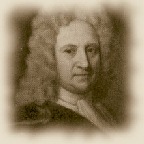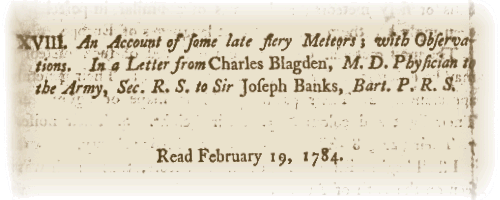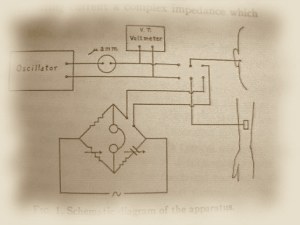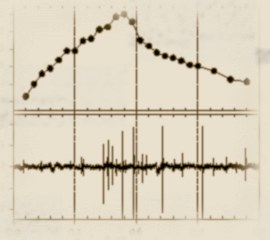read more: Electrophonic sounds - introduction
read more:
Electrophonic sounds - existing catalogs
Electrophonic sounds:
History
Reports of strange noises heard simultaneously with the
passage of a bright fireball have a long history. Without doubt, some are
even hidden in very old Sumerian, Arab and Chinese chronicles. For example,
a Chinese record from the year 817 about the meteor ``which made a noise
like a flock of cranes in flight'' [12],
or an Arab record of a meteor shower in the year 1026, probably Perseids,
which had meteors with ``a loud sound and intense light'', (see the record
19 in [13]).
As soon as the first scientific magazines appeared, such observations were
regularly recorded in them.
A Mystery of Meteors in the 18th
Century
 At the beginning of 18th century, sir Edmund Halley
dismissed the electrophonic sounds by interpreting them as imagination
of observers [14,15].
In his letter to the Royal Society of London in 1714 [14],
he describes several bright meteors visible over Europe in previous years
and derives their heights from witness reports at widely separated locations.
He obtained heights of several tens of miles, which suggests that a sound
from a meteor can not be heard simultaneously with the meteor's appearance.
He also quotes Italian astronomer Geminian Montanari from Bolonia,
who derived similar result for a bright meteor in 1676 over Italy:
At the beginning of 18th century, sir Edmund Halley
dismissed the electrophonic sounds by interpreting them as imagination
of observers [14,15].
In his letter to the Royal Society of London in 1714 [14],
he describes several bright meteors visible over Europe in previous years
and derives their heights from witness reports at widely separated locations.
He obtained heights of several tens of miles, which suggests that a sound
from a meteor can not be heard simultaneously with the meteor's appearance.
He also quotes Italian astronomer Geminian Montanari from Bolonia,
who derived similar result for a bright meteor in 1676 over Italy:
"..famous Meteor which was seen to pass over Italy,
on the 21st. of March O.S.Anno 1676, ... its perpendicular Altitude was
at least 38 Miles: That in all Places near this Course, it was heard to
make a hissing Noise as it passed, ... it was heard to give a very great
Blow, (Tuono di maggior rumore di gross Cannonata), immediately after which,
another sort of Sound was heard, like the rattling of a great Cart running
over Stones, which continued about the time of a Credo. ... it cannot be
wonder'd that so great a Body moving with such an incredible Velocity thro'
the Air, tho' so much rarefied as it is in its upper Regions, should occasion
so great a hissing Noise, as be heard as such a Distance as this was."
A few years later, Halley had the opportunity to apply
the same analysis on a bright meteor over England in March of 1719 [15].
The large height and velocity of the meteor completely excluded the reality
of "hissing" sounds which accompanied the meteor:
"Of several Accidents that were reported to
have attended its Passage, many were the Effect of Fancy, such as the hearing
it hiss as it went along, as if it had been very near at hand: Others imagin'd
they felt the Warmth of its Beams, and some there were that thought, at
least wrote, that they were scalded by it."

At
that time, the origin of meteors was unknown , and Aristotel's view of
meteors as atmospheric phenomena was generally accepted. Intrigued
by reports of instantaneous "hissing" sounds from a large meteor on August
18, 1783, Sir Charles Blagden is presenting his arguments for "electric
origin of meteors"[16]
in 1784. Since the nature of electricity was still not understood, he describes
meteors as ``electricity fluid". In this picture, there is a possibility
for this fluid to travel faster then sound and produce "hissing" sounds
around an observer:
"Various electrical phenomena have been seen
attending meteors. Lambent flames are described as settling upon men, horses,
and other objects, and sparks coming from them, or the whole meteor itself,
it is said, have damaged ships, houses, etc. in the manner of lightning.
These facts, I must own, are but obscurely related, yet still they do not
seem to be destitute of foundation. If there be realy any hissing noise
heard while meteors are passing, it seems explicable on no other supposition
then that of streams of electric matter issuing from them, and reaching
the earth with a velocity equal to that of the meteor, namely, in two or
three seconds. Accordingly, in one of our late meteors, the hissing was
compared to that of electricity issuing from a conductor. The sparks flying
off so perpetually from the body of fire-balls, may possibly have some
connection with these streams. In the same manner the sound of explosions
may perhaps be brought to us quicker, then if it were propageted through
the whole distance by air alone."
Although his description of meteors was incorrect, he
correctly assumed that the instantaneous sounds are of electrical origin.
It is interesting that he compares these sounds with the aurora sounds
and derives the height of aurora to be even higher than meteors. Thus we
can say that this is also the first attempt of explaining both type of
sounds with the same theory.
Understanding of the Meteors
in the 19th Century
 A
real breakthrough in understanding the origin of meteors happened after
the great Leonid meteor storm in 1833. From an extensive collection of
witness reports, Denison Olmsted derived heights and trajectories of the
meteors and rightly concluded that meteors are low density objects from
space that burn-out high in the atmosphere [18].
He also gave a very detailed summary of reports from many witnesses of
instantaneous sounds, some of whom were scientifically trained, and discusses
the results of their electrical and magnetic experiments [17].
These crude experiments did not reveal any certain change in the magnetic
field of the Earth, but many electrical anomalies were positively recorded. A
real breakthrough in understanding the origin of meteors happened after
the great Leonid meteor storm in 1833. From an extensive collection of
witness reports, Denison Olmsted derived heights and trajectories of the
meteors and rightly concluded that meteors are low density objects from
space that burn-out high in the atmosphere [18].
He also gave a very detailed summary of reports from many witnesses of
instantaneous sounds, some of whom were scientifically trained, and discusses
the results of their electrical and magnetic experiments [17].
These crude experiments did not reveal any certain change in the magnetic
field of the Earth, but many electrical anomalies were positively recorded.
"...No change was noticeable in the magnetic
dip, variation or intensity. Gold leaf electrometers were excited by a
touch, Bennett's, placed on the prime conductor, with the cushion insulated,
rose on a slight motion of the machine. The pendulum of <De Luc's dry
pile> was accelerated."
"Mr.Palmer, considering the phenomenon as electrical,
immediately made some experiments to ascertain the electrical state of
the atmosphere. His silk pocket-handkerchief held at one end in the right
hand and drawn swiftly through his left hand, emitted a very unusual number
of electric sparks. On turning a small machine, he found the sparks which
were usually short and feeble, much longer and more intense then he had
ever seen before. On presenting silk threads to an iron bar that stood
on the ground leaning against the house, they were strongly attracted towards
the iron. He next examined his compas; found the needle more unsteady then
ordinary, but on adjusting it to the meridian as nearly as he could, judged
the declination of the needle to be the same as usual."
"He heard at different times a number of slight
explosions, which usually resembled the noise of a child's pop-gun, and
was not unlike that of a fire-rocket. They were followed by a particular
odor observed by all the company, (four men) which one compared to the
smell of sulphur, and another to that of onions. The meteors which afforded
these sounds, all passed along in a north-west direction.... They passed
below the tops of the trees at the distance of twenty five rods from
the place where he stood, giving a "pop" just before they reached
the trees. One appeared to strike the barn, and gave a louder pop then
any of the others. An auroral light resembling day-break, appeared constantly
in the east from the time when his observations commenced."
Since the Olmsted's calculations excluded the electric
origin of meteors, these instantaneous, (anomalous), sounds were dismissed
also and disappeared from the scientific publications later on, even though
Olmsted did not exclude their existence:
"Meteors which were distinguished for their
brightness and apparent magnitude, and which would therefore be expected
to afford sounds, might stil be too distant for such sounds to be audible;
or might be in a region of the atmosphere where the air is too much
rarefied for the purpose of sound.
...
The question whether any sounds proceeded from the meteor, must
rest, for its decision, on the circumstances of the case; such as the peculiarity
of the sounds, their nature as described by different observers, etc."
Revival of the Anomalous Meteor
Sounds at the end of the 20th Century
 The
term electrophonic sound was introduced by S.S. Stevens in 1937
for sensation of a sound caused by electrical current through the head[19].
A few years later, in 1940, the name electrophonic bolide
was introduced by P. Dravert as a description of a bright meteor accompanied
by, (anomalous), sound [20].
Although the existence of electrophonic sounds from meteors was generally
ignored or dismissed as the imagination of observers, there were attempts
by some authors to rise the problem of the origin of these sounds. For
example, in 1917, J.A. Udden [35]
proposed dissipation of the ether waves into sound waves "... on objects
attached to the earth, such as plants or artificial structures." The
term electrophonic sound was introduced by S.S. Stevens in 1937
for sensation of a sound caused by electrical current through the head[19].
A few years later, in 1940, the name electrophonic bolide
was introduced by P. Dravert as a description of a bright meteor accompanied
by, (anomalous), sound [20].
Although the existence of electrophonic sounds from meteors was generally
ignored or dismissed as the imagination of observers, there were attempts
by some authors to rise the problem of the origin of these sounds. For
example, in 1917, J.A. Udden [35]
proposed dissipation of the ether waves into sound waves "... on objects
attached to the earth, such as plants or artificial structures."
The idea that radio, (ether), waves can be produced by
meteors was checked for the first time experimentally by A.G. Kalashnikov
in 1949 [21].
He reported the detection of ULF pulses, (at frequency of 1 Hz), coincident
with meteors, but this remained a controversial result as other authors
performed similar experiments during the 1950's [22,23,24,25].
During that time, the first catalogs of electrophonic
sounds appeared [26,27,28].
The most influential was the RAND Corporation report made by M.Romig and
D.Lamar [28],
which was widely accepted in the West as the last word on this subject.
In Russia some work continued, mostly theoretical, usually inspired by
the mystery of Tuguska explosion in 1908.
 The
situation finally started to change in 1980, when C.S.L. Keay presents
the theory that meteors can emit the ELF/VLF radio waves [2].
According to his laboratory experiments, these electromagnetic waves can
be transformed into sound on ordinary objects around the observer. The
ELF/VLF radiation [4]
would be produced by trapping and tangling Earth's magnetic field in the
turbulent plasma tail of an ablating meteoroid. Soon after, using this
theory, Bronshten gave theoretical prediction that a meteor with minimal
brightness of -12m, (about equal to the brightness of a full
Moon) is necessary for production of electrophonic sounds [3]. The
situation finally started to change in 1980, when C.S.L. Keay presents
the theory that meteors can emit the ELF/VLF radio waves [2].
According to his laboratory experiments, these electromagnetic waves can
be transformed into sound on ordinary objects around the observer. The
ELF/VLF radiation [4]
would be produced by trapping and tangling Earth's magnetic field in the
turbulent plasma tail of an ablating meteoroid. Soon after, using this
theory, Bronshten gave theoretical prediction that a meteor with minimal
brightness of -12m, (about equal to the brightness of a full
Moon) is necessary for production of electrophonic sounds [3].
Since then the interest for electrophonic sounds has been
rising. New catalogs were introduced [29,30,31],
and extensive statistical analysis of catalogs of electrophonic sounds
was presented by Kaznev in 1994 [10].
His results show a variety of electrophonic sound properties, and clearly
show that the lover brightness limit of -12m is not realistic.
Keay refined his theory in 1992 and predicted that VLF can be generated
in the moment of the explosive disintegration of a bright bolide, and also
a little bit earlier [8].
Nevertheless, this still requires slow meteors ablating at low altitudes,
while some electrophonic bolides are clearly very fast and ablating at
high altitudes, (Leonids, for example).
In 1991, Bronshten gave a very valuable overview of the
vital facts and existing theories, (mostly Russian), about electrophonic
sounds [32]
and/or mechanisms for VLF emission from meteors. His conclusion is that
all proposed theories are too simplified to be able to give the right answers
and future detailed numerical modeling of the kinetic plasma theory equations
may give more precise results.
Recently, a new theory of Electrophonic Bursters was
presented by M. Beech and L. Foschini [9]
but it also has difficulties like the other theories.
In the meantime, a few reports of detected ELF/VLF radiation
from meteors have been presented [6,7][33][34]
but a much larger sample is needed for more definite conclusions about
the physics of these radio emissions from meteors. Finally, during the
1998 Leonid meteor shower, the first instrumental detection of electrophonic
sound was obtained [34].
Nevertheless, the phenomenon of electrophonic sounds from
meteors is still mysterious. It is not clear how the meteors can produce
such a strong ELF/VLF emission and what kind of observational conditions
are necessary for detection of these sounds. Thus the witness reports are
very valuable source of information.
Copyright 1999 Zeljko Andreic, Dejan Vinkovic
Read about more recent developments in the ILWCRO press release regarding the
first instrumental detection of electrophonic meteors:
fizika.org/ilwcro/results
read more: Electrophonic sounds - introduction
read more: Electrophonic sounds - existing catalogs
Other sources of information about the electrophonic
sound:
Colin Keay's Home
Page
Phil Bagnall's
Home Page
Dejan Vinkovic (University
of Kentucky)
|

![[EPFL]](../logo_epfl.gif)
![[University of Kentucky]](../logoUKY.gif)
![[The International Meteor Organization]](../logoIMO.gif)

 At the beginning of 18th century, sir Edmund Halley
dismissed the electrophonic sounds by interpreting them as imagination
of observers [
At the beginning of 18th century, sir Edmund Halley
dismissed the electrophonic sounds by interpreting them as imagination
of observers [
 A
real breakthrough in understanding the origin of meteors happened after
the great Leonid meteor storm in 1833. From an extensive collection of
witness reports, Denison Olmsted derived heights and trajectories of the
meteors and rightly concluded that meteors are low density objects from
space that burn-out high in the atmosphere [
A
real breakthrough in understanding the origin of meteors happened after
the great Leonid meteor storm in 1833. From an extensive collection of
witness reports, Denison Olmsted derived heights and trajectories of the
meteors and rightly concluded that meteors are low density objects from
space that burn-out high in the atmosphere [ The
term electrophonic sound was introduced by S.S. Stevens in 1937
for sensation of a sound caused by electrical current through the head[
The
term electrophonic sound was introduced by S.S. Stevens in 1937
for sensation of a sound caused by electrical current through the head[ The
situation finally started to change in 1980, when C.S.L. Keay presents
the theory that meteors can emit the ELF/VLF radio waves [
The
situation finally started to change in 1980, when C.S.L. Keay presents
the theory that meteors can emit the ELF/VLF radio waves [